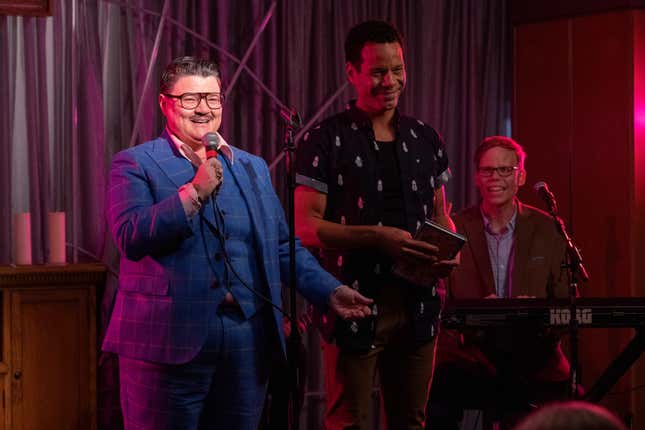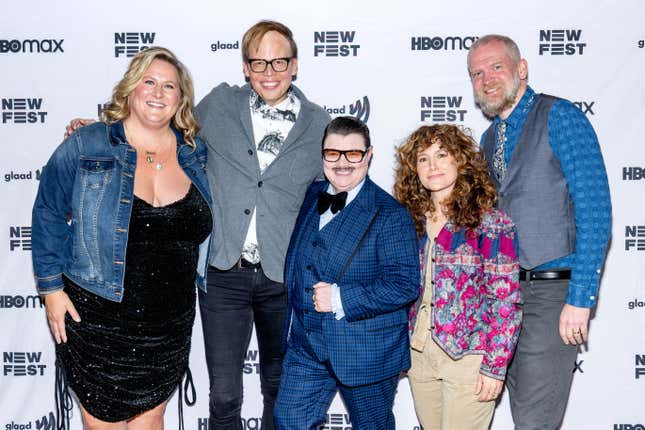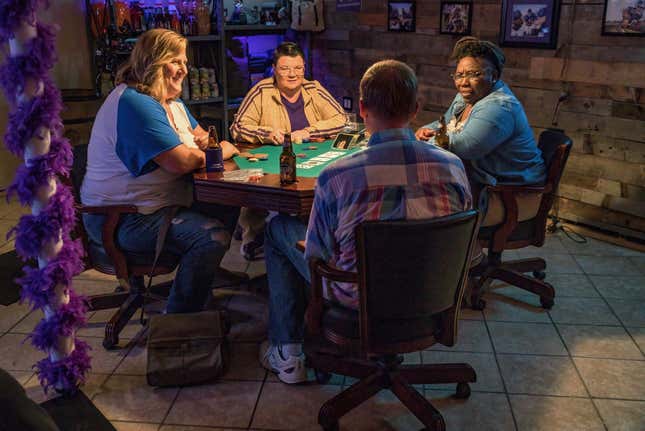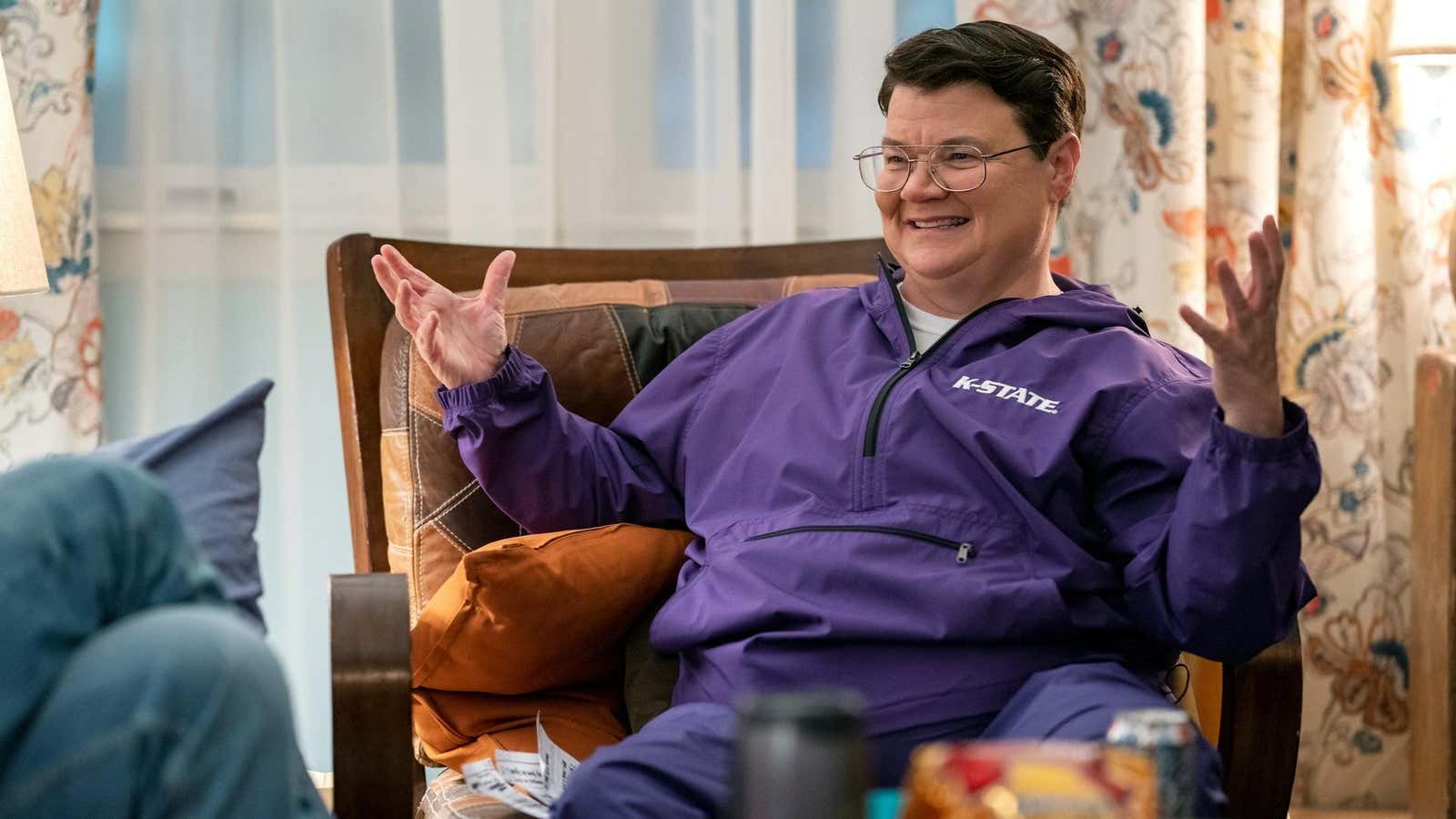Somebody Somewhere is set in the rural town of Manhattan, Kansas, and follows Sam (Bridget Everett), a 40-something who’s struggling to find a sense of purpose in her hometown while mourning her sister’s death. Imbued as it is with gravitas and humor, introspection and self-effacement, the camp and the mundane, the show lands “somewhere” (pun intended?) between drama and comedy. Just watch it—Season 2 premiered Sunday on HBO—and you’ll see how the showrunners and cast create that “realness” everyone is talking about.
And while Somebody Somewhere is about feeling lost, it doesn’t pin much blame on rural Kansas. Unlike The Wizard of Oz, there is no hopeful tornado to take Sam away from the place she grew up (though there is a very literal tornado). Nor is Sam arriving to this sleepy little town from the big city, thus armed with the worldly perspective one garners from a concrete jungle. Instead, she stays close to home and finds her chosen family in a crew of local misfits, many of whom are queer. That crew includes Fred Rococo, played with an indelible mix of humor, sensitivity, and tenderness by New York City nightlife performer Murray Hill.
“I think Fred and I share the same spirit and wink and twinkle in the eye,” Hill told Jezebel. “The difference...well, Fred is an agricultural professor and I’ve got a PhD in showbiz.” Or, as Everett described to Jezebel, “Fred is the more rural, stripped-down version of Murray. Still lovable, still funny, but more interested in grain reports than zingers.”

By night, Fred is the master of ceremonies for a secret gathering, covertly referred to as “church” by Sam’s newfound crew. We first encounter him behind a podium at the head of the tabernacle, wearing a baby blue suit, aviator glasses, and gold rings. In a leisurely manner—the kind you reserve for people you know, for your neighbors—he welcomes a modest crowd for the evening’s variety show (a toned-down version of Hill’s larger-than-life gigs in New York). But by day, Fred is a soil scientist at the local university, and this is the Fred we meet in Episode 2 of the first season when he joins Sam, Joel (Jeff Hiller), and Michael (Jon Hudson Odom) out to brunch. It’s a family-style place with no frills, the kind of locale many of us have memories of frequenting: fidgeting in a high seat next to our parents, going on our first date, nursing a hangover with our college roommate. Here, Fred wears a gray tee with a purple hoodie, and a black baseball cap with a purple brim. He makes easy chat with Sam, gently corrects a server who misgenders him, and good-naturedly joshes his mates for racking up high bills after he offered to pay.
Why detail these scenes? They aren’t overtly dramatic—which is par for the course for Somebody Somewhere. They don’t establish life or death stakes for a queer character at odds with their community or open a window into the suffering one experiences from being different. Nor do they depict a glamorous 20-something figuring life out against an exotic backdrop. And that’s precisely the point.
Fred is a person at ease in his surroundings. Like Hill says, he’s “the guy who lives next door, but it’s a few blocks away.” He’s a presence but not a spectacle. In short, the rural town of Manhattan, Kansas, is his home. Set within the history of transmasculine representation, this normalness, this everyday character, is pretty radical.
Transmasculine Representation in Film and TV
For decades, transmasculine and masc-of-center nonbinary representation in film and television was sparse, and when it did exist, tended to reflect damaging misconceptions about the community. The 2020 Netflix documentary Disclosure traces the earliest film allusions to transmasculinity back to D.W. Griffith’s Judith of Bethulia (1914)—yes, the same D.W. Griffith who made The Birth of a Nation, “the most reprehensibly racist film in Hollywood history.” Not surprisingly, the depiction was derogatory.
Before the 2010s, hit movies like Yentl, Victor/Victoria, and She’s the Man served as a fulcrum for allowing transmasc viewers to imagine living openly: in school, at work, or as a sensation on the stage. But these stories ultimately undermined that very dream. After all, a woman dressed as a man for a purpose—for protection, to get a job, to go school—not because it was his identity. As such, there was always a redemption scene, when she shucked off her male attire and reverted to her feminine form (sigh of relief). And the male protagonist who was in love with the “boy” was saved from the crisis of being a homosexual because the object of his affection was a girl (second sigh of relief).
When movies and TV did feature trans men, they often conveyed traumatic lessons about how society perceived them. In a 1997 episode of Jerry Springer, “My Boyfriend Is a Girl,” Reno revealed to his girlfriend that he was trans. As Monique wept into her roommate Tammy’s arms, Tammy declared, “Reno, you need to be telling people. Do you see what you caused?” In 2006, The L Word introduced the trans character Max (portrayed by trans nonbinary actor Daniel Sea), whose testosterone therapy made him volatile, at times aggressive—a toxic stereotype. He also faced the threat of ostracism from the lesbian community he was once a part of, sending a daunting message that coming out could result in rejection, even within queer spaces.
In 2000, Hilary Swank won an Oscar for playing Brandon Teena, a transmasculine Nebraskan who was murdered. Boys Don’t Cry memorialized Brandon’s life and underscored how, historically and contemporarily, trans persons are the victims of violence—but the story of an attack on a trans man called attention to a psychologically and physically horrific experience, too. Moreover, Swank’s Oscar win reflected an undermining paradox: While being a trans person resulted in persecution, a straight, cis-gendered actor pantomiming trans experiences resulted in accolades. (Years later, Eddie Redmayne got an Oscar nomination for The Danish Girl and Jared Leto won for Dallas Buyers Club.)
Fortunately, there has been a major shift in trans stories over the last decade, which has extended to transmasculine actors and characters—including on popular shows like The Umbrella Academy, Good Girls, and Grey’s Anatomy. As Time wrote in a 2020 article, “These roles are revolutionary not only in their casting of trans actors, but for their three-dimensionality, allowing for stories which move beyond experiences of coming out, trauma and transphobia, both external and internalized.” There has been a rise in diversity, too: Logan Rozos starred in OWN’s David Makes Man; Ian Alexander is in Star Trek: Discovery and The OA; Leo Sheng is in The L Word reboot and Garcia was in the Netflix reboot of Tales of the City. Moreover, nonbinary actors like Billions’ Asia Kate Dillon, 13 Reasons Why’s Bex Taylor-Klaus, and Our Flag Means Death’s Vico Ortiz expand conceptions of masculinity to contemporary audiences.
On the one hand, this new generation of actors is proving to be a celebratory counterpoint to previous perceptions of transmasc people. They are beautiful, hip, contemporary, and dynamic. On the other hand, the characters they play are not wholly representative of transmasculine experiences. Trans people come in every age and size, and from every region of this country. Brian Michael Smith, Chaz Bono, Ian Harvie, and Michael Cohen are working trans performers over 40, but their age group is outnumbered by the surge of young talent entering the scene. Where are the plus-size, disabled, or elderly transmas characters? Where is the trans man working the 9-5? The grocery store clerk? The truck driver? The preacher? The farmer? The one living in rural America? These are but a few examples.
“Visibility is what gets trans women killed. Invisibility is what contributes to trans men killing ourselves… If you can’t see yourself, it’s really hard to be yourself,” trans actor Scott Turner Schofield told Vice last summer. And like Cohen said in Disclosure, “We are creatures who want to see our stories reflected back at us… We just need more.”
A Nuanced Transmasc Experience in Rural America
We’ve seen queer stories in rural settings before Somebody Somewhere. In Schitt’s Creek, a rich family loses all their money and is forced to move to the boonies, where their attempts to live a “normal life” are met with one faux pas after another. (Think Paris Hilton frying pizza slices with a pair of irons, on repeat.) In One Mississippi, Tig Notaro returns to her hometown after a family loss and has to come to terms with being an outsider. In both cases, the town is the butt of the joke, which makes Somebody Somewhere stand out all the more.
Everett—who is herself from Manhattan, Kansas—created the show alongside Hannah Bos and Paul Thureen. “Part of what I wanted to ask was, what would have happened if we didn’t leave? If Bridget and Murray and Joel never left?” Thureen said at a Somebody Somewhere Season 1 finale screening. He expanded on that idea to Jezebel: “Of course, the value of chosen family isn’t exclusive to small towns, but having grown up in rural America—my dad was a farmer in Minnesota—that’s what I knew. I think those chosen families are so moving because you grab on to the people that allow you to be yourself, and that’s when serious and silly things happen. That can literally be a lifesaver and also, hopefully, a fun and captivating place to be.”

Murray Hill’s portrayal of Fred Rococo living in small town nowhere is arguably one of the most subtly nuanced transmasculine characters on the screen today. This scene from Season 1 provides a good example: One minute Fred is chatting to his student, “All right Nelson, I’ll see you in lab. I’ve got some nitrifying bacteria to show you that’s going to warp your mind.” Then he gently teases Sam for assuming Professor Jankowski, who we never meet, is a man: “Wow, I cannot believe you just assumed he was a man. Well, you’re a good guesser. Women are woefully underrepresented in the agricultural sciences.” The naturalness with which this all unfurls is no small feat. Perhaps Thureen and Bos achieved what few others have: writing a trans man whose other traits—soil scientist, MC, friend, teacher—are not outweighed by his gender identity.
But last year, articles citing transmasc characters on the small screen left Fred out. It’s weird to say, but it might have been a compliment. Unlike many characters, his transness is not his core trait, nor was he placed within the cast to add diversity.
“We tried to not have queer characters carry the burden of teaching everyone a lesson or saving the day in a cliché way, or have any characters who were there just to advance a plot point,” Bos told Jezebel. “We tried to focus on full humans, with jobs and needs and dreams, that didn’t talk like they were in a TV show. We think it’s very important, and we just hope we can keep doing it and go deeper and deeper.”
When Hill first came to New York in 1990, there were few parts in the entertainment industry for trans men and nonbinary persons. He started in drag and then, over the next 25 years, became a major entertainer in the cabaret scene. Yet, it was only last year that Hill made his big TV break, when he was cast in Life and Beth, Welcome to Flatch, and Somebody Somewhere. This June, he will be hosting Hulu’s new show Drag Me to Dinner. In some ways, he embodies the years of struggle the community has undergone to gain access. It makes his performance as Fred even more rewarding to watch.
“I’ve been around a long time, pre-internet even! Back then, the world went nuts when Ellen was on the cover of Time with the caption, ‘Yep, I’m gay.’ Her show was canceled because of it,” Hill said. “In some ways, we’ve come a long, long way from then. Yet, if you take a step back and look at the entire community, the improvements of representation are not equal at all. Lesbians, transmasc, drag kings...are still largely in the shadows. I started 25 years ago to raise the visibility of people like me, and I’m still doing it.”
For Trans Awareness Day, about a month before Season 2 of Somebody Somewhere premiered, Hill posted a statement on Instagram: “Respectfully, leave us alone. Let us be. Let us live. It’s that simple. We aren’t going anywhere.”
The statement immediately brings to mind the latest examples of anti-trans legislation and discrimination, but “let us be” also points to more subtle inequalities, including within Hill’s industry. “Do heterosexual or ‘straight’ actors, comedians, or folks get asked their sexual identity? Do they get asked in every interview how they identify? Of course not,” he said. “I believe in equality. I want to be treated like everyone else and connect on the basis of our collective humanity. To me, that’s a political act. I’ve said this before: The moment a label or disclaimer goes before my name, it’s reductive and not treating me as an equal to the ‘mainstream.’ I don’t lead with my identity. I lead with my heart. I’m Murray Hill.”

He makes a good point. The call for more transmasculine stories—for better storytelling and more opportunities for trans actors—is part of this larger goal: to just be. On screen, Hill’s Fred shows us something hopeful about just being in the Americana landscape.
The Beauty of Somebody Somewhere
“I have crisscrossed the United States half a dozen times and counting. I came out as transgender in Atlanta, Georgia; fell in love in Bloomington, Indiana; and found my ride-or-die friends in East Tennessee. This is what I’ve learned on my travels: America is a deeply queer country,” Samantha Allen writes in Real Queer America. America is also a country riddled with anti-LGBTQ legislature. According to translegislation.com’s 2023 Anti-Trans Bills Tracker, 500 such bills have been filed in the U.S. (43 have passed so far). Seventeen states have passed bans on gender-affirming care; the House just voted in favor of banning trans women and girls from school sports.
“It’s a shitshow out there right now. I have to constantly remind myself, not everyone is filled with hate. Those who are, are very loud and make a lot of noise with their negativity,” Hill said. “I was just in Florida for a gay wedding and it was the most beautiful love fest I’ve ever been to. Families, chosen families, neighbors, and friends all gathered in Florida on public grounds, and it was beautiful. Not one person was thinking about [Governor Ron] DeSantis. We gotta fight the bitter fight, of course, but we need to celebrate the joy, too.”
Hill believes that his character Fred conveys that message: “Fred, by being who he is, shows he’s just like everyone else...breathes the same air, has a big heart, cares about people. If the haters see us as people first, there will be a lot more harmony and less fear.” Fred’s deeply rooted life in Kansas also disavows the messaging that rural America is inherently inhospitable and hostile to the queer community. In Somebody Somewhere, rural America itself is not something to overcome. It’s home.
Amanda Chemeche is a queer writer and folk musician living between Edinburgh and NYC. A Yale and Trinity College Dublin alumni, they are currently working on their first book and completing a Creative Writing MFA at Columbia University.
